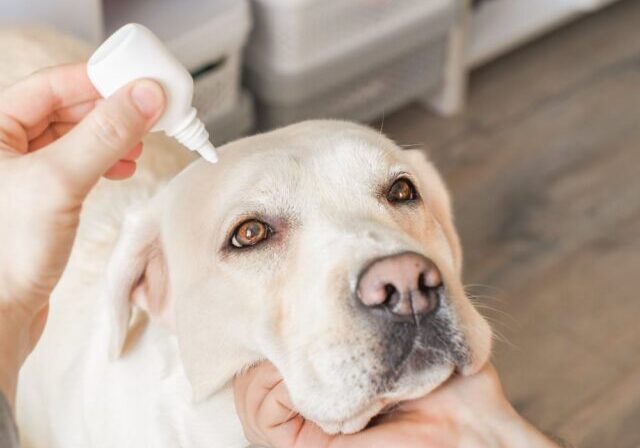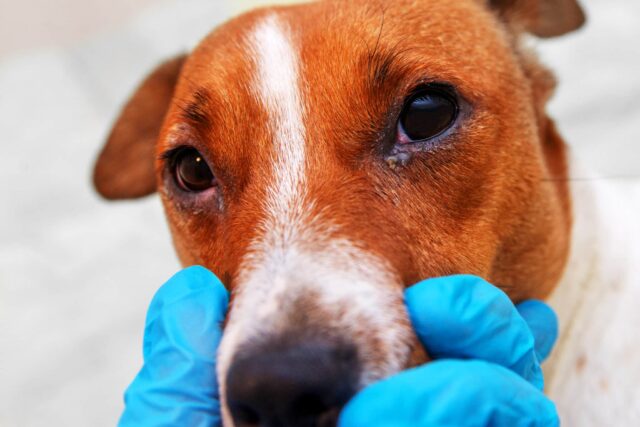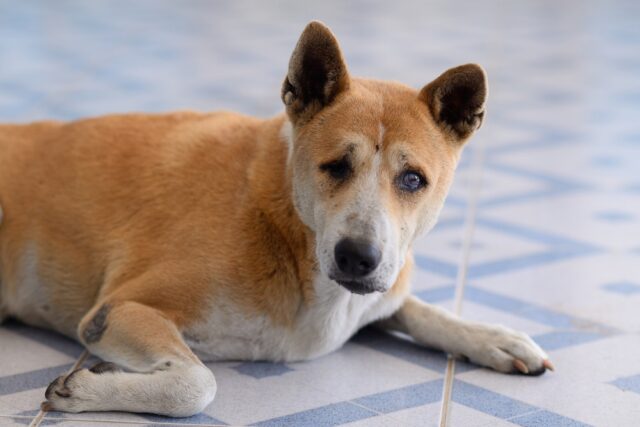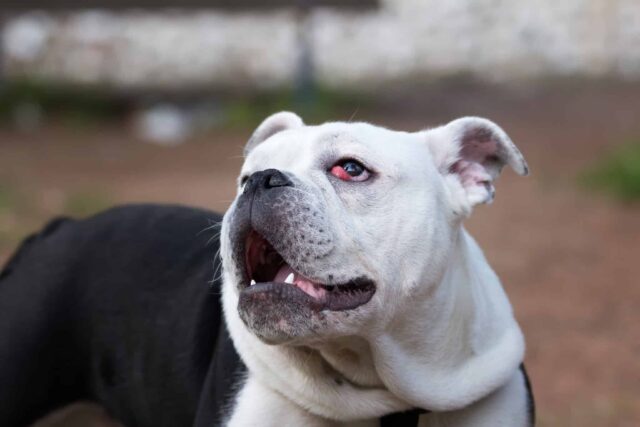Eye health is extremely important for our canine companions, as we want them to be able to see without issue. You’ll notice that one of the things your veterinarian looks at during your pup’s yearly check-up is their eyes. Sometimes issues go unseen by owners in the early stages, but there are other issues that are noticeable right away. Although some are more serious than others, it’s important to understand the common eye ailments that affect our dogs. This isn’t a complete list of disorders, it’s some of the most typically seen.

Related: Our Favorite Eye Supplements for Dogs
#1 – Corneal Ulcers
Corneal ulcers are essentially scratches or erosions on the cornea, which typically occur from injury but can be caused by other ailments. Although they’re not usually as bad as they sound, corneal ulcers should be treated as soon as you notice symptoms. Partially closing the eye, rubbing the face, and excess tear production are all signs that something is off with your dog’s eye and an ulcer might be the cause. Cat scratches, playing with other dogs, thorns and even tall grass can injure your dog’s eye.
#2 – Cataracts
Cataracts affect the lens of your dog’s eye, causing their vision to become impaired and eventually results in complete blindness. Many owners confuse nuclear sclerosis, a common and similar-looking condition that occurs as dogs age, with cataracts. But the two are very different. With the normal aging process of nuclear sclerosis, the vision may be affected but not to the extent of a cataract. Cataracts are usually genetic in dogs, however some conditions like diabetes can contribute to the disorder. Cataracts can be surgically repaired, although it is an expensive procedure and is not typically recommended by veterinarians unless vision is sure to be repaired.
#3 – Dry Eye
Dry eye, also called keratoconjunctivitis sicca (KCS), is a condition in which the tear glands produce fewer tears than is normal for dogs. In some cases, tear production is completely absent. Dogs with KCS typically have thick, yellow discharge coming from the eyes. Their eyes become red and the cornea eventually turns brown. If left untreated, KCS will eventually lead to blindness. Medication is often used to manage the symptoms of KCS and in severe cases, surgery to redirect a saliva duct to the eye is an option.
#4 – Glaucoma
Eyes have a system of fluid and drainage that helps keep them at the right pressure inside the skull. When this becomes disrupted, the pressure within the eye increases. Glaucoma is painful, and symptoms include redness, an enlarged eye, dilated pupils, a visible third eyelid, increased tear production, and corneal cloudiness. Glaucoma will result in blindness, so early treatment is the best option. There are two types of glaucoma – primary and secondary. Primary is a problem with the eye drainage itself, whereas secondary is an issue with the drainage as a result of other infections. Roughly 40% of dogs with glaucoma lose their vision in the affected eye, so treatment is essential.
#5 – Progressive Retinal Atrophy
Progressive retinal atrophy, or PRA, is a degeneration of retinal tissue in the eye, resulting in blindness. PRA is a genetic, inherited disorder, so breeds prone to this disease should undergo testing prior to breeding. According to Eye Care for Animals, “The slow loss of sight is similar to a dimming switch to reduce brightness of light in a room. If light is slowly reduced over a long period of time, our eyes adapt and the change is not noticed until darkness occurs. A similar situation occurs in progressive retinal atrophy in animals; often the condition is not noticed until the condition is significantly progressed.” Unfortunately, there is no cure and no treatment for PRA. Thankfully, the condition is painless and the dogs usually adapt quite well to life with minimal to no vision.
#6 – Cherry Eye
Dogs have a third eyelid, and a prolapse of that eyelid is called cherry eye. The third eyelid usually hides from the view of humans and is held in place by special ligaments. When these ligaments fail, for whatever reason, the third eyelid pops out and the pink/red fleshy tissue is visible, giving the condition its name. Cherry eye is most commonly fixed with surgery and is a genetic condition that usually affects both eyes over time (if the dog is affected). Veterinary treatment should be sought after, as cherry eye will cause your dog to have a dry eye, which will lead to blindness over time.
#7 – Entropion/Ectropion
Entropion is a condition in which the eyelid grows inward towards the eyeball, causing the eyelashes or sometimes the lid itself to rub against the eyeball. This causes corneal ulcers, which in turn lead to other ailments, including blindness if left untreated. It’s most often a genetic condition but can also be caused by chronic squinting, due to other eye ailments. On the contrary, ectropion is a condition in which the eyelid droops and rolls outwards from the eye. This causes red, watery and irritated eyes and can be uncomfortable for the dogs. Entropion can be fixed with surgery, while ectropion is usually left alone depending on severity.
#8 – Conjunctivitis
Conjunctivitis, or pink eye, can happen in our dogs too. This condition is essentially the inflammation of the conjunctiva and is generally thought of a symptom rather than a disorder on its own. Physical irritation, just as that from scratches, dust, or entropion, as well as allergies, are common causes of conjunctivitis in dogs. However, bacterial and viral infections in the eye do occur, and the ailment can be present on its own without a primary cause. Treatment is generally easy, and veterinary attention should be sought if you notice any symptoms such as redness, drainage, and discomfort.

These statements have not been evaluated by the Food and Drug Administration. This product is not intended to diagnose, treat, cure, or prevent any disease. The information on this website is not intended to replace a one-on-one relationship with a qualified health care professional.



 Toledo, United States.
Toledo, United States.